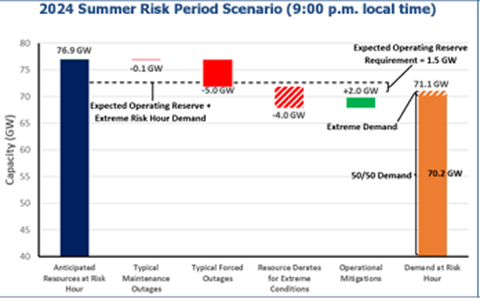News
better business decisions
Posted 1 year ago | 7 minute read

ERCOT alerts…explained
During the extreme summer heat or volatile weather conditions in Winter, Texas’ electrical grid can be put under strain. To help manage the supply of electricity with the demand, the grid operator ERCOT may ask Texans to conserve power during peak hours. At other times, they may issue warnings of conditions that may require future conservation or action. But what do they all mean and what could we expect for the 2024 summer peak period?
Weather Watch
ERCOT issues a Weather Watch three to five days in advance of “significant weather” such as extreme heat with the potential to increase electrical demand.
Voluntary Conservation Notice
This alert asks Texans to voluntarily decrease energy usage during peak demand periods, if it’s safe to do so. The goal is to decrease demand while ERCOT works internally to manage the grid as higher demand is forecast with a lower energy supply.
Conservation Appeal
ERCOT issues Conservation Appeals to ask residents, businesses, schools and governments to decrease electricity use if it’s safe to do so. This elevated request comes when higher demand and lower reserves are predicted and could require emergency operations.
Operating Condition Notice (OCN)
ERCOT describes an OCN as “the first of four levels of communication issued in anticipation of a possible Emergency Condition,” or “an operating condition in which the safety or reliability of the ERCOT System is compromised or threatened.”
An OCN is the warning that there are conditions present that may result in further action being taken in the future to protect the power grid, but there is not yet an Emergency Condition where ERCOT is asking Texans to conserve power or requiring utility services to shed load through controlled power outages.
Following an OCN, ERCOT may issue three other communications indicating the increasing likelihood of an Emergency Condition including advisories, watches and finally, an emergency notice to declare that ERCOT is operating in an Emergency Condition.
Energy emergency levels
When electricity demand is greater than the supply, ERCOT begins emergency operations to prevent an uncontrolled system-wide outage. To prevent uncontrolled outages ERCOT may issue calls for conservation, deploy reserves or implement controlled outages to reduce demand on the system.
When it issues an emergency alert, ERCOT can use additional power sources that may be available only during emergency conditions with the overall goal of keeping the grid functioning.
There are three levels of Energy Emergency Alerts and each level provides ERCOT with resources to protect the power grid.
- Energy Emergency Level 1: Operating reserves have dropped below 2300MW and are not expected to recover within 30 minutes. Conservation is critical and there is a risk of controlled outages. “ERCOT can call on all available power supplies, including power from other grids, if available.”
- Energy Emergency Level 2: Operating reserves have dropped below 1750MW and are not expected to recover within 30 minutes. Conservation is critical and there is a risk of controlled outages. “ERCOT can reduce demand on the system by interrupting power from large industrial customers who have contractually agreed to have their electricity turned off during an emergency.”
- Energy Emergency Level 3: Operating reserves have dropped below 1430MW and are not expected to recover within 30 minutes. Conservation is critical and controlled outages are underway. “ERCOT will order transmission companies to reduce demand on the electric system. This is only used as a last resort. This is typically done through [controlled] rotating outages and temporary interruptions of electric service. In extreme circumstances, more prolonged outages may be required.”
Summer 2024 forecasts
As a result of continued vigorous growth in both loads and solar and wind resources, there is a risk of emergency conditions in the summer evening hours when solar generation begins to ramp down, according to NERC’s 2024 Summer Reliability Assessment released on May 15.
The report noted that also contributing to the elevated risk is a potential need, under certain grid conditions, to limit power transfers from South Texas into the San Antonio region. These grid conditions can occur when demand is high and wind and solar output is low in specific areas, straining the transmission system and necessitating South Texas generation curtailments and potential firm load shedding to avoid cascading outages.
The modelling performed by NERC indicates an elevated risk of having to declare an EEA during evenings on peak load days in August—the forecasted summer peak load month. The probability of declaring an EEA is 18.4% during the highest risk hour. The probability of firm load shedding is 14.6% during the highest risk hour.
ERCOT expects to have sufficient operating reserves for the August peak load hour given expected normal summer system conditions. Solar and battery energy storage installed capacity has grown by about 4,500 and 1,600MW, respectively, since last August. ERCOT’s probabilistic risk assessment indicates an elevated risk of having to declare EEAs during hours ending 8:00–9:00 p.m. Central on the August peak load day. ERCOT judges an hour to have elevated risk (as opposed to low risk) when the probability of an EEA is greater than 10%. The EEA probability for these two hours is about 16% and 18%, respectively.
Contributing to the elevated risk is a potential need, under certain grid conditions, to limit power transfers from South Texas into the San Antonio region. Conditions could cause overloads on the lines that make up the South Texas export and import interfaces, necessitating South Texas generation curtailments and potential firm load shedding to avoid cascading outages. The risk is greatest when ERCOT has extremely high net loads in the early evening hours. This issue will be addressed with mitigation measures including the construction of the San Antonio South Reliability Project, which is anticipated to be completed by Summer 2027.

Source: NERC
Demand response in ERCOT
In ERCOT, nearly 3,500MW of DR resources are expected for this summer, the equivalent of 4% of normal peak demand.
- ERCOT’s controllable load resources (CLR) consist of large loads (e.g. data centers) and battery charging systems that can be dispatched by ERCOT to provide frequency regulation and short-notice resources for managing wind and solar ramps; 600MW of CLRs are registered.
- Non-controllable load resources (NCLR) consist of “blocky” loads with both a 10-minute ramp capability for manual deployments and automatic deployment through underfrequency relay. NCLRs participate in ERCOT’s Responsive Reserve Service market. ERCOT expects just over 1,100MW of participation for the highest reserve risk hours for the upcoming summer.
- Some DR resources participate in ERCOT’s Emergency Response Service (ERS), along with distributed generation. ERCOT’s ERS consists of 10- and 30‐minute-ramping DR and distributed generation that can first be deployed when physical responsive capability (PRC) drops to 3,000MW to provide a contingency reserve.
During the 2023 program year, ERS was deployed twice, once on August 17, and again on September 6 when ERCOT’s PRC dropped below 3,000MW. ERCOT expects approximately 1,000MW to participate in ERS for the highest reserve risk hours for the upcoming summer.
- Transmission and distribution service provider (TDSP) load management programs provide price incentives for voluntary load reductions from commercial, industrial, and, most recently, residential loads during EEA Level 2 events. These programs have historically only been available for the months of June through September from 1:00–7:00 p.m. on weekdays (except holidays) and deployed via ERCOT instruction pursuant to agreements between ERCOT and the TDSPs. ERCOT forecasts that these programs can provide 330MW in demand relief this summer. In addition, ERCOT Nodal Protocols allow ERCOT to instruct TDSPs to reduce customer load by using existing, in-service distribution voltage reduction measures to avoid an EEA. Conservation voltage reduction (CVR) can lower demand by nearly 575MW.
- ERCOT accounts for load-reduction programs administered by retail entities in its load forecast. The 4-Coincident Peak (4CP) Load Reduction program incentivizes customers to reduce load during four anticipated 15-minute peak-load intervals, one each across the summer months of June, July, August, and September. The amount of load reduction for the four 4CP days in 2023 averaged 4,674MW. Additionally, retail entities offer a variety of price response programs that are factored into ERCOT’s load forecast.

Forecaster
From accurate forecasts, advanced trading strategies, and real-time analysis, through to robotic trading and asset optimization and control, our services helps you increase margins, optimize financial returns, and navigate the complexities of the energy market with confidence.
Learn more





